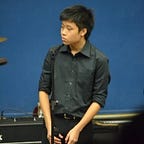GROUNDED iPhone Stand
Ideas…
This project started as a reaction to Logitech’s new Wireless Charging Stand for iPhone, POWERED:
There was something about the sharp angular edges that I felt clashed with the smooth (>G2) curves of the iPhone. I also didn’t like how the iPhone in landscape orientation was just sitting there and could be easily misaligned, since Qi wireless charging requires that the phone lines up with the wireless coil just right in order to charge.
So I designed the guiding edge for the phone in landscape, and I made sure all the curves in my design were G2 (what Fusion could manage). The great thing about a wireless charging dock vs a traditional Lightning dock was that the phone could be in landscape view and still charge, while you are watching a video.
First, I needed to get the specifications of the iPhone. So I found Apple’s iPhone 8 specifications for case manufacturers online.
Unfortunately, I couldn’t find the specifications for the curvature of the iPhone anywhere (Apple’s pretty secretive about their designs), so I did the next best thing and imported the design specifications as sketches into Fusion, and tried to curve the corners using G2 curvature continuity to best fit the sketch. It isn’t perfect, but it’ll do for now. Also, it’s questionable how much difference would it make since I’m using 3D printing, an inaccurate manufacturing process at best.
I then began the arduous task of forming the shape of the product, applying the iPhone’s curves to the corners of the object as much as I could.
The back plate where the Qi wireless charging coil resides would be made by MDF, and inserted into the 3D printed model at a 25 degree angle, which I arrived at after considering how the phone would be used in portrait and landscape. The back plate, I decided, would embody the essentials: just enough plate to house the coil, which is circular in shape, and combining that form with the curves of the iPhone is how I arrived at such a shape.
I soon realised that the base needed support on the back, as the back plate extended quite high above the ground, and would be prone to toppling over. I sketched a support at the same angle of 25 degrees extending downwards towards the ground, which made the design more coherent and also provided a way to cover the previously awkward (and flimsy) thin layer of plastic ending at the bottom, just behind where the MDF base plate would sit.
Throughout the process, I also had to ensure that the wireless charging coil aligned properly with the coil in the iPhone in both orientations.
Other features include a hole in the back to connect the power cable, which didn’t turn out very well due to support printing in the hole, and the difficulty in getting it out.
One more little detail that was hard to get was how I made the two sides of the MDF back plate almost disappear into the base itself when viewed from the bottom of the table.
For the first prototype, I decided to go with 15% density and at a faster speed just to try out its strength and quality.
For the final product I went with 65% density and at a slower speed to refine details and make it heavier and thus, more sturdy.
POST-MORTEM
Even though I made the gap for the MDF back plate a little bigger (about 0.5mm wider than MDF’s 3mm), it was still a little tight to get in due to the amount of surface area in contact with the plastic. I could afford to make it wider even at the expense of making it a bit loose due to it being held in place vertically by the plastic base anyway.
